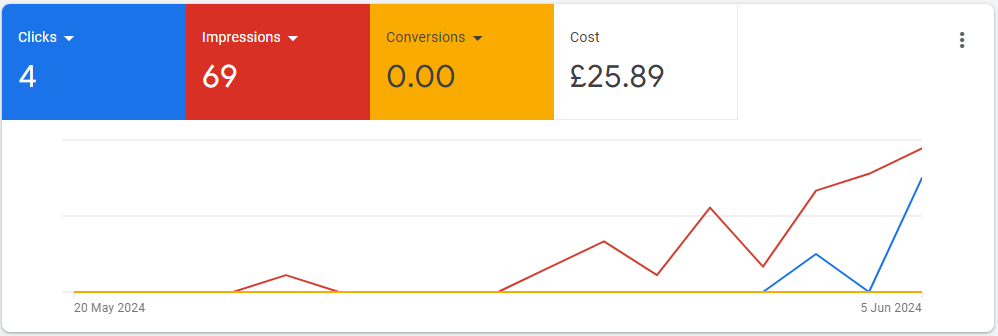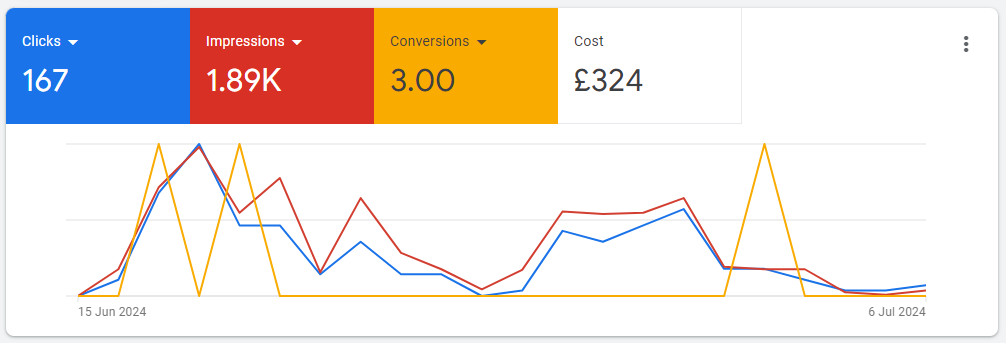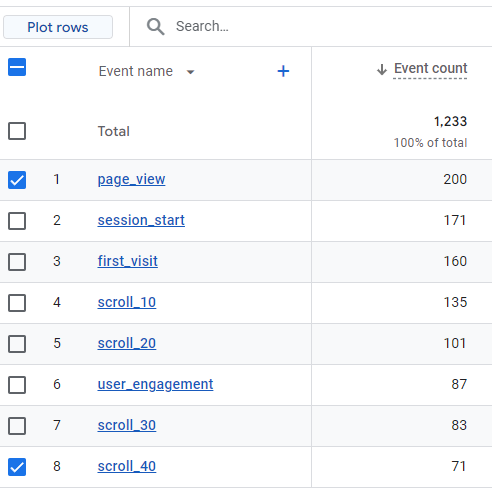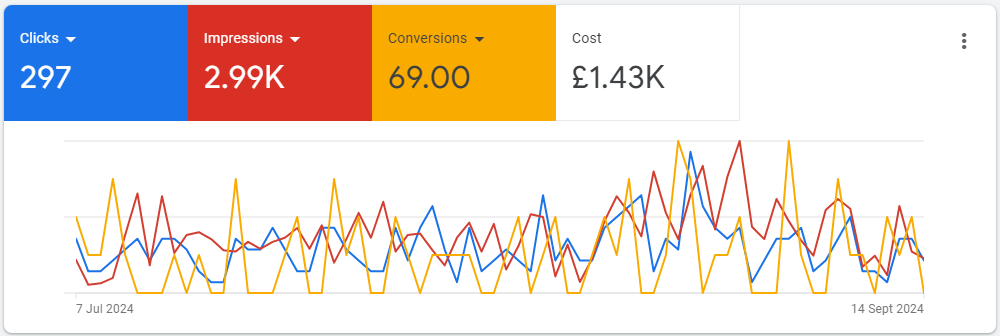At BIGMatrix, we recently faced an intriguing challenge. A client reached out to us, and they had an agency running Google Ads for them. However, their previous campaigns weren’t converting and only had a few impressions and clicks. Our task was to figure out why and turn things around. Here’s how we approached it, what changes we made, and the impressive results we achieved.
The Starting Point: Identifying the Problem
Before we took over, the previous agency’s campaign setup was flawed, and the performance reflected that. Here’s what we found:

- Campaign Period: 20/05/2024 – 05/06/2024 (17 days)
- Total Clicks: 4
- Total Impressions: 69
- Total Conversions: 0
- Cost: £25.89
The main issue was the way the previous campaign was structured. They used multiple ad groups, each containing only one exact match keyword. While having tightly themed ad groups can sometimes be effective, this setup led to several problems:
- Over-Segmentation: By creating many ad groups with only one exact-match keyword each, they limited the campaign’s ability to gather sufficient data for optimization. Each ad group struggled to gain impressions because exact-match keywords restrict the reach of ads to very specific search queries.
- Limited Traffic: Exact-match keywords require a search to exactly match the specified phrase. Although this approach can attract highly relevant traffic, it severely limits impressions if search queries don’t align perfectly with the keywords. In this case, the campaign received a meager 69 impressions and 4 clicks over 17 days, which is far too low to drive meaningful conversions.
- Poor Optimization: Google’s algorithm optimizes ad delivery based on performance data. By spreading the budget thinly across many ad groups, each with minimal data, it became nearly impossible for Google Ads to learn and optimize effectively. This resulted in very little traffic and, ultimately, zero conversions.
- Narrow Targeting: Exact-match keywords don’t capture related search terms that potential customers might use. In contrast, broader matching types (like phrase-match or broad-match modifiers) can encompass a wider range of relevant searches, bringing in more quality traffic.
Because of this flawed campaign setup, the ads were barely shown, and when they were, they failed to resonate with potential customers. We knew that a complete overhaul of the campaign strategy was needed.
Our Approach: Overhaul the Campaign and Landing Page
As our entry step, we combined all ad groups and the keywords into a single ad group. In addition, we left keywords with 1-2 words as a broad match and left the rest as a phrase match.
Before diving into more changes, we wanted to start collecting the performance data. Therefore, the only logical step was to set up advanced Google Analytics using Google Tag Manager. This allowed us to track:
- Scroll depth – how far visitors scrolled down the page.
- Interactions – clicks on buttons, images, links, and text.
Surprise Surprise, we instantly started seeing waaaaay more impressions, clicks, and even few conversions:

But… At the same time, the metrics that we started tracking provided insight into visitor behaviour on the landing page. The data revealed a crucial issue: most users (~65%) dropped off after scrolling only 40% of the page. This was a clear sign that the page failed to engage visitors from the start.

Now, we can start optimising while looking at the data! (this is fun! We love data!)
Step 1: Keyword Optimization – Fixing the Traffic Problem
The first task was to address the poor campaign structure:
- Keyword Research: We conducted in-depth research to identify targetable keywords that aligned with what potential customers were searching for.
- Switch to Phrase-Match: To narrow down targeting, we replaced ALL broad-match keywords with phrase-match keywords. This allowed us to reach more relevant search phrases, ensuring ads were shown to users with a higher intent to convert.
- Exploratory Keywords: To explore additional audience segments, we added new keywords as broad matches. Broad match keywords helped the campaign gain impressions and clicks, which provided more data for future optimization.
By using phrase-match and strategically selected broad-match keywords, we ensured that the ads could reach a broader, yet still relevant, audience. This change helped solve the initial problem of the campaign’s limited impressions and clicks.
Step 2: Complete Landing Page Redesign – Turning Traffic into Conversions
As you already know, we also identified that the landing page contributed to the lack of conversions. As a reminder, ~75% of visitors dropped off after scrolling only 25% of the page. Soooo, this happened because a generic service offering page (like any other service page on the internet, with all the headers and the footers and external links and internal links, and so on…) was used as the landing page. So, in short, IT WAS NOT OPTIMISED FOR CONVERSIONS.
We decided to create a separate page designed for this specific campaign that would use the same keywords. So here is the whole list of what we did on the landing page:
- Header: Removed unnecessary links to keep visitors focused on the page. We don’t want visitors to switch attention somewhere else, don’t we?
- Hero Section: Communicated the service offering clearly and included star ratings from trusted sources to build immediate trust. Because everyone loves stars.
- Reassurance Section: Included details about rates, processes, and experience right after the hero section to reinforce credibility.
- Service Offering: Displayed a concise list of services with descriptions, prices, and “Book Now” buttons.
- Customer Testimonials: Provided social proof with real customer testimonials.
- Final Reassurance: Highlighted insurance, certifications, and customer rights to address concerns and encourage conversions.
- Booking Form: Embedded the booking form on the page to keep the conversion process streamlined and friction-free. Yes, FORM ON THE SAME PAGE, for the same reason as point 1.
The Results: Turning Things Around
Now the best part – DATA! Don’t we all want to know how the campaign performed?
| Metrics | Before Changes (ran for 22 Days) | After Changes (ran for 69 Days) |
|---|---|---|
| Total Clicks | 167 | 295 |
| Total Impressions | 1,890 | 2,980 |
| Average Daily Impressions | 85.9 | 48.19 |
| Total Conversions | 3 (booooo) | 69 |
| Conversion Rate | 1.8% | 23.4% |
| Conversion Value (avg. £51) | £153 | £3,519 |
| Cost | £324 | £1,430 |
| Cost per Conversion | £108 | £20.72 |
Here’s what the Google Ads graphs looks like:

Key Insights
- Better Keyword Strategy = Higher Quality Traffic: Switching from the narrow one-keyword-per-ad-group approach to using phrase-match keywords significantly increased the campaign’s reach and quality of traffic. While the average daily impressions decreased (from 85.9 to 48.19), this was a sign of better targeting. We focused on attracting users who were genuinely interested, leading to a higher click-through rate (CTR) of 9.92% after the changes.
- Higher Conversion Rate: The conversion rate jumped from 1.8% to 23.4%. This dramatic increase resulted from the improved keyword targeting and landing page that was designed to keep visitors engaged and guide them seamlessly through the conversion process.
- Cost Efficiency: Cost per conversion dropped drastically from £108 to just £20.72. By focusing on relevant search terms and engaging traffic with a conversion-optimized landing page, we maximized the return on ad spend (ROAS) and reduced wasted budget.
Our Thought Process: Why This Approach Worked
Consolidating Keywords: By grouping related keywords into more comprehensive ad groups, we provided Google Ads with enough data to optimize effectively. The switch to phrase-match targeting expanded our reach to include variations of relevant search queries, attracting more quality traffic.
Landing Page Overhaul: Advanced tracking revealed where users were dropping off. We used this insight to redesign the page with trust signals, clear service offerings, and streamlined booking processes. This kept visitors engaged and reduced bounce rates, ultimately driving more conversions.
Conclusion: From Poor Setup to Conversion Powerhouse AKA Data-Driven Decisions Lead to Success
The previous campaign’s setup, with its over-segmented structure and restrictive exact-match keywords, was a major barrier to success. We transformed the campaign’s performance by rethinking the keyword strategy and redesigning the landing page. The results speak for themselves: more impressions, higher-quality clicks, a huge conversion increase, and a dramatic drop in cost per conversion.
What’s next?
We are working closely with a client to identify other opportunities to grow their business. Currently, we have identified these opportunities:
- Some of the conversions (yes, they were excluded from this data-driven use case) were from bad leads. This means our client has to call to book a service, but after calling the visitor, they refuse the service.
- We are working on launching one more campaign to increase visibility. This campaign will be for a slightly different service. “But why do you need a new campaign if the service is similar?” you might ask. Well, even though the service is similar, the target audience is very, very different. TL;DR: One audience requires a one-time service, while the new audience requires the same service on a weekly/monthly basis.
Join our newsletter so you don’t miss our case studies and continuation of this case study (new campaign included).